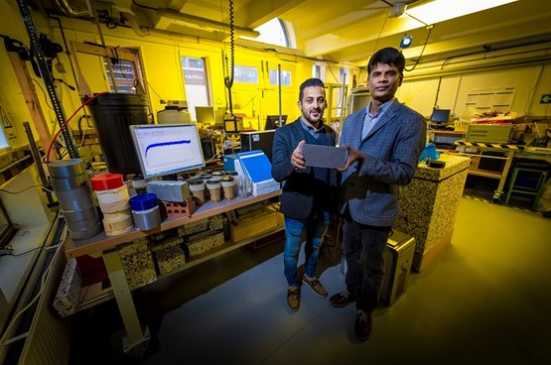A new brick that is claimed to offer 10 times better insulation than traditional clay bricks has been 3D printed from domestic waste.
Dr Karthikeyan Kandan, senior lecturer in mechanical engineering at De Montfort University Leicester (DMU), has created the brick entirely from upcycled plastic waste.
The brick is 3D printed with criss-crossing strips of the plastic materials to form a grid, or weave, which has been inspired by the nest of the Baya weaverbird, which is found on the Indian subcontinent. The nest is renowned for its elaborately woven construction.
Kandan said: “The baya weaverbird’s nest’s ingenious construction gives it excellent thermal insulation and mechanical properties for inhabitation.

PhD student Saad Alqahtani and Dr Karthikeyan Kandan
“Inside there is a central nesting chamber, which makes it the ideal micro-climate for inhabitation. By replicating this structure, we have manufactured a brick that improves energy efficiency of modern buildings and therefore can reduce carbon footprint.”
Thermal insulation tests showed that the brick has a U-value of 0.25 Watts per metre Kelvin (W/m²K). This is 10 times more effective than a clay brick, which delivers an average of 2.94 W/m²K. U-value is a measure of the flow of heat through an insulating or building material: the lower the U-value, the better the insulating ability.
Kandan said: “Our brick, made from all kinds of domestic plastic waste – from coffee cup lids to plastic bottles – exhibits a tremendous thermal envelope over conventional building materials.
“This provides significant potential to not only improve the energy efficiency of modern building, but also to conserve space and reduce dead-weight in multi-story buildings.”
Comments
Comments are closed.














This is a great idea, however further information on how the product reacts to fire and UV degradation should be published before it is considered as a viable construction material.
Very good, but what about the structural integrity ratings compared to clay bricks? and how do you bond these bricks with mortar/glue? what about cutting these bricks? and brick specials?
And it fire performance test results are ….?, along with structural performance and embodied carbon?
High insulation normally equates to high combustibility,